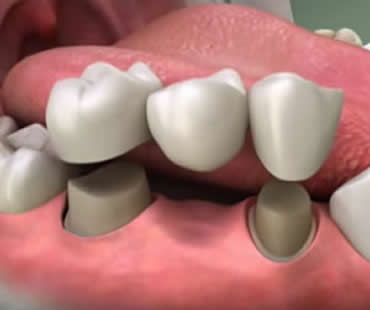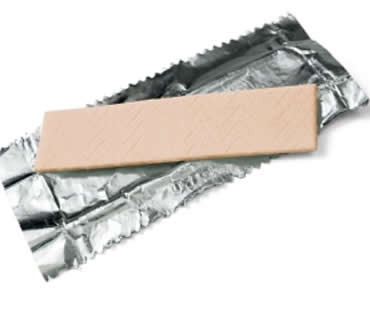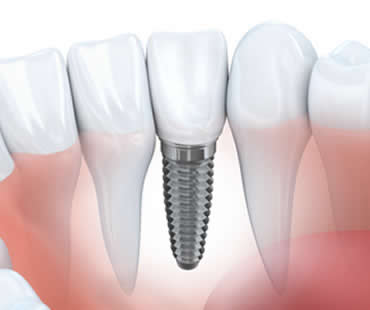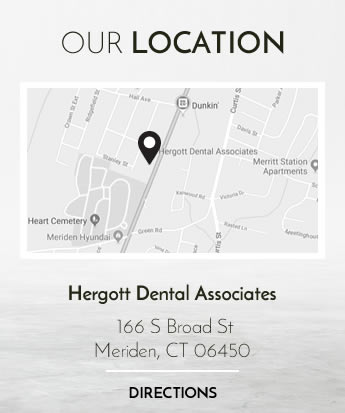
There are times when a tooth is so damaged from decay, trauma, or cracking that a filling isn’t the best choice. In these cases, a dental crown may be recommended for long-term tooth health. If a tooth is missing completely, your dentist may suggest a dental bridge to fill the gap between two bordering teeth.
Dental crowns, or “caps,” completely cover and protect your damaged tooth. It is bonded in place, giving you a stable, strong, and attractive alternative for your original tooth. Because it is customized for you using impressions your dentist makes of your teeth, it is a perfect match in size, shape, and position to your natural tooth.
Dental crowns can be the perfect solution to a severely damaged tooth. You won’t need to worry about pain, tooth stability, or your appearance when you choose a dental crown. Depending on what material is used, your crown can look as natural as your own tooth.
Dental bridges are designed to span a gap caused by a missing tooth. Having a gap in your smile can affect you in more ways than just cosmetics. Chewing and talking can become problematic as teeth adjacent to the gap begin to shift, leaving the potential for gum disease or jaw issues.
Dental bridges literally bridge the gap between two teeth. They are cemented onto the pair of teeth that border the empty space vacated by one or more missing teeth. The bordering teeth act as anchors for the bridge, and are trimmed down to hold a dental crown. Between the two crowns is a replacement tooth, customized for you by your dentist. Once the bridge is in place, you will regain the ability to smile freely while the bridge maintains the shape of your face and lips. You will speak more clearly and be able to eat a greater variety of foods. A dental crown also protects your healthy teeth from issues related to bite alignment.
Dental crowns and dental bridges are excellent choices for overall dental health, and can last a lifetime. To prevent damage to your dental work, avoid chewing things like ice or hard candy. It is also important to maintain regular dental checkups.
We offer dental crowns at our Meriden dental office

Gone are the days when chewing gum is considered poor etiquette. In today’s society, you can find people chewing gum in business meetings, church, and just about every other situation. With gum chewing so prevalent, you may have wondered what it’s doing to people’s teeth. You may be surprised to learn that research shows that chewing sugarless gum has a number of dental benefits. Let’s see how it can actually be a helpful addition to your oral care routine.
Saliva flow
Chewing sugarless gum increases the flow of saliva in your mouth, which rinses away food particles. Saliva also neutralizes acids that result from bacteria in your mouth that can lead to tooth decay. Known to carry with it calcium and phosphate, increased saliva flow also helps strengthen your tooth enamel.
ADA acceptance
Choose gum with the American Dental Association (ADA) Seal, indicating it as met the required safety and effectiveness criteria. This approval means that you can trust the gum’s packaging and labeling to be true.
Sugarless
The only gums carrying the ADA Seal are sugarless. They contain sweeteners that don’t cause cavities, like aspartame, mannitol, sorbitol, or xylitol. Chewing gum with xylitol is especially recommended, because it has been shown to combat tooth decay and cavities.
Dental hygiene
Even though chewing gum can be beneficial, remember that brushing and flossing are still the best ways to care for your teeth. Brush twice a day with fluoride toothpaste, and floss every day to remove plaque and debris between your teeth. Between these dental hygiene tasks, however, it is acceptable to chew sugarless gum to continue caring for your mouth during the day.
If you live in the Meriden area contact us today

Dental implants are the best restorative choice for replacing a tooth that is missing. Whether the tooth has come out due to some kind of facial trauma or an infection or other issue, dental implants are the solution. The real difference in quality between a dental implant and other restorations such as bridges lies in the fact that the dental implant is placed directly into the patient’s jawbone, eventually fusing there through a process known as ossification.
Over time, ossification provides the kind of tooth base that is only seen elsewhere in natural teeth. When a dental implant is successful, it is as secure and as natural looking as a patient’s own original teeth; however, in some cases, dental implants fail. Sometimes they fail repeatedly. What’s causing these dental implant failures? Here are some potential causes.
Sometimes the implant doesn’t fuse with the bone and the bone shrinks away from the implant, leading to implant mobility or even the implant falling out. Patients who have weak bones due to age, osteoporosis, years of being edentulous (toothless) or another medical condition will find dental implants more challenging. If you’ve been having issues with failure to ossify, your dentist might recommend a bone graft to rebuild the jawbone to a healthy level so that dental implants can properly fuse.
In other cases, persistent infection may result in repeated implant failure. Signs of infection are continuous bleeding, swelling at the implant site or acute inflammation of the gum tissue at the implant site. Pus may be evident, or a bubble might appear on the gumline. Some health issues such as diabetes, auto-immune disorders or treatments like cancer therapies can weaken the immune system and leave the implant site vulnerable to infection. Your dentist might prescribe antibiotics or recommend you see an endodontist for a root canal treatment.
If you’re concerned about your dental implant, talk to Meriden dentist Dr. Hergott right away. Find out what steps you need to take to ensure that your dental implants are successful.
If you need a dentist in Meriden contact us today

Dentistry today does not just include treatments for tooth and gum problems or diseases. The trend in dentistry has expanded to include a wide range of treatments and procedures with the purpose of improving your appearance. The purpose of cosmetic dentistry is to give you the most appealing smile possible so that you can be happy with your look and have an improved self-esteem. Here are some trends in cosmetic dentistry explained.
Bonding
Mild to severely damaged teeth can be treated with dental bonding. A tooth-colored material is applied to the fractured or chipped surface of your tooth and then bonded with a special light. The restoration provides a renewed look to your tooth so that others can’t even tell it was ever damaged.
Teeth whitening
A bright white smile gives of a great impression of oral health and beauty. Stains from age, foods, drinks, and habits like smoking all play a role in making your smile dull and unattractive. Cosmetic dentists offer teeth whitening procedures that can turn your smile around in just an hour.
Veneers
Another way to easily improve your smile is dental veneers. These thin shells usually made of porcelain are permanently adhered to the fronts of your teeth, giving you a bright and flawless smile for many years to come.
Contouring
Instead of having lengthy orthodontic treatment to correct crooked teeth or uneven spacing, contouring is an option to improve your look. Also called tooth reshaping, this procedure is additionally used to correct irregularly shaped teeth and alter issues like overly pointy teeth. During contouring, small amounts of tooth enamel are removed in order to change the tooth’s shape, length, or surface.
Implants and dentures
To replace missing teeth, dental implants are dentures are both options depending on the patient and the specific situation. Many people prefer implants because they are a permanent and secure solution.
Cosmetic dentist in Meriden

If you have tooth pain or another issue, you might wonder what a visit to the dentist may reveal. You may need a root canal procedure. In order to properly evaluate your issue and to confirm the need for a procedure, a dentist will examine several factors. These typically include the symptoms you are experiencing, the signs observed, and any additional testing required to confirm an initial theory.
You may have noticed:
- You experience average to severe pain that lingers, during or immediately after drinking hot liquids or food, or very cold liquids or foods.
- You have pain, swelling, or sensitivity when biting or chewing on a certain tooth.
- Your tooth pain disrupts your life, preventing you from sleeping through the night or conducting your daily business without taking an over-the-counter pain reliever.
- You have a “bubble” on your gum, similar to a pimple. When irritated, it may release blood or pus that can smell or taste bad.
- You have pain that radiates out from one tooth to other areas of your head or jaw. For example, a tooth pain can lead to a pain behind the eye like a headache or to the ear, resulting in earache symptoms.
- You have a discolored tooth that is darker than the surrounding teeth. A grey tooth can indicate a “dead” tooth.
- You have a broken or cracked tooth with obvious signs of damage or decay.
Your dentist may have noticed:
- A tooth problem revealed by x-rays
- A recurring or persistent gum pimple (also called “fistulous tracts”)
- A tooth that has changed color
Additional testing:
- X-ray examination – if x-rays did not reveal the problem, they can provide an extremely clear picture of tooth health
- Percussion testing – a gentle tapping on the teeth to evaluate pain response
- Thermal testing – a careful application of a hot or cold stimulus to evaluate sensitivity
Sometimes, teeth needing to undergo a root canal procedure have no symptoms discernible to the patient. It is important to visit your dentist regularly to ensure the proper diagnosis and treatment needed to maintain life-long oral health.
If you need root canal treatment in the Meriden area, contact our office today to schedule a consultation.

The desire for a better looking and better functioning smile has been around since ancient times. As early as 3000 BC, there is evidence that people used sticks to clean their teeth. Early toothbrushes were made of animal hair in the late 15th century.
The earliest forms of cosmetic dentistry are believed to be dentures made from ivory and bone by the Etruscans around 700 BCE. Other dentures were made from animal or even human teeth taken from corpses. Near 200 CE, the Etruscans had moved on to using gold to perform the functions of a dental crown or bridge.
Ancient Egyptians made a whitening toothpaste of vinegar and ground pumice stone, while the Romans utilized the ammonia from urine in their toothpastes, a practice that existed in some form into the 1700s.
Dental implants of human teeth were used in Europe in the 1700s for replacement teeth, but the practice was rejected due to repeated failures. Over the next hundred years, metal was used – and was also subsequently rejected.
The end of the 18th century and the entre 19th century showed great strides in cosmetic dentistry, particularly in the field of prosthetic dentistry, with the success of the porcelain denture. Molds were made of existing mouths with plaster, allowing dentists to provide the greatest denture fit and comfort available to patients thus far.
In the 1840s, the first rubberized material used as a base for dentures was invented, called Vulcanite. The first dental lab created specifically to produce prosthetic dental appliances was established in the 1850s. Porcelain dental crowns gave way to porcelain fused to metal crowns in the 1950s, and Vulcanite gave way to acrylic in the early 20th century, materials we still use today.
Your cosmetic dentist in Meriden is a skilled professional whose techniques have been practiced and refined by those dentists who came before for thousands of years. Today, we are at the pinnacle of the knowledge and expertise of trained cosmetic dentists and with the variety of successful methods and materials that will work for any cosmetic need.
If you live in the Meriden area contact us today














